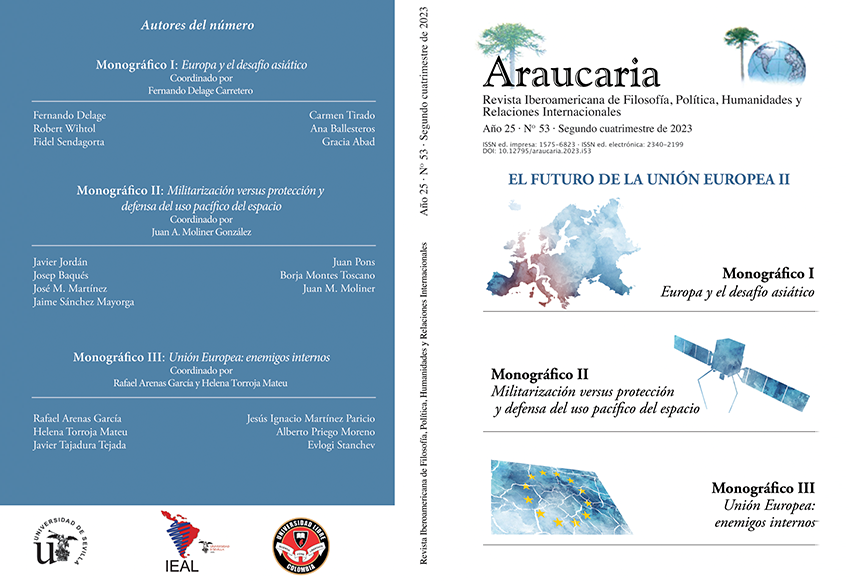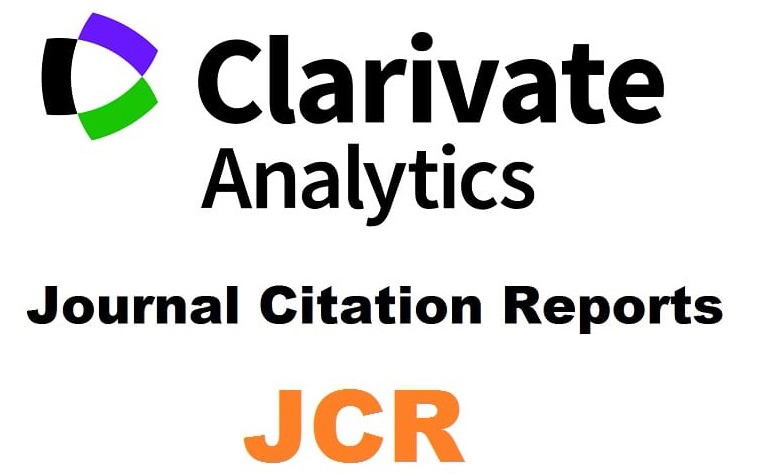Europa en la era de Eurasia y del Indo-Pacífico
Europe in the Eurasian and Indo-Pacific era
DOI:
https://doi.org/10.12795.araucaria.2023.i53.01Palabras clave:
Europa, Asia, Eurasia, Indo-Pacífico, Globalización, GeopolíticaResumen
El desplazamiento del centro de gravedad de la economía mundial hacia Asia, la transición geopolítica hacia un sistema multipolar cuya principal variable es la rivalidad entre Estados Unidos y China por el dominio del Asia marítima, y el desafío que plantea a la identidad universalista europea el auge de un continente cuyos valores culturales y concepción de la política se apoyan en otras perspectivas, sitúan a Europa ante un escenario inédito pero que condicionará en buena medida su futuro. El ascenso de Asia reduce el peso relativo de Europa, pero le obliga asimismo a reorientar su estrategia económica y geopolítica si no quiere verse marginada en la reconfiguración en curso del orden internacional.
Descargas
Citas
Allard, Patrick y Frédéric Grare. “European trade and strategy in the Indo-Pacific: Why the EU should join the CPTPP”, European Council on Foreign Relations, 1 diciembre 2021.
Bubalo, Anthony y Malcolm Cook. “Horizontal Asia”, The American Interest, vol. 5, núm. 5 (2010), pp. 12-19.
Calder, Kent E. Super Continent: The Logic of Eurasian Integration, Stanford, Stanford University Press, 2019.
Commission of the European Communities. “Towards a New Asia Strategy”, COM(94) 314 final, Bruselas, 13 julio 1994.
Commission of the European Communities. “Europe and Asia: A Strategic Framework for Enhanced Partnerships”, COM(2001) 469 final, Bruselas, 4 septiembre 2001.
Delage, Fernando. “China: diplomacia económica, consecuencias geopolíticas”. En Jordi Marsal, ed., Geoeconomías del siglo XXI, Madrid, Ministerio de Defensa, 2017, pp. 55-91.
Delage, Fernando. “La Ruta de la Seda y la “Nueva Era” de la República Popular China: fundamentos, objetivos, implicaciones”. En José Mª Beneyto y Enrique Fanjul, eds., El Papel de España en la Nueva Ruta de la Seda: Oportunidades, Retos, Recomendaciones, Cizur Menor: Thomson Reuters Aranzadi, 2018, pp. 29-57.
Deng, Yong. “The Role of the EU in Asian Security: Between Transatlantic Coordination and Strategic Autonomy”, Asia Policy, vol. 15, núm. 1 (2020), pp. 105–126.
Diesen, Glenn. Europe as the Western Peninsula of Greater Eurasia: Geoeconomic Regions in a Multipolar World, Lanham, Rowman & Littlefield, 2021.
Dragneva, Rilka. The Eurasian Economic Union: Putin’s Geopolitical Project, Filadelfia, Foreign Policy Research Institute, 2018
Draper, Peter y Naoise McDonagh. “The missing anchor: Why the EU should join the CPTPP”, Lowy Institute Policy Brief, 20 octubre 2021.
Esteban, Mario y Miguel Otero-Iglesias, eds. “Europe in the Face of U.S.-China Rivalry”, A Report by the European Think-Tank Network on China (ETNC), enero 2020.
European Commission. “Connecting Europe and Asia - Building blocks for an EU Strategy”, JOIN(2018) 31 final, Bruselas, 19 septiembre 2018.
European Commission. “The EU strategy for cooperation in the Indo-Pacific”, JOIN(2021) 24 final, Bruselas, 16 septiembre 2021.
Frankopan, Peter. The Silk Roads: A New History of the World, Londres, Bloomsbury, 2016.
Frost, Ellen L. Asia’s New Regionalism, Boulder, Lynne Rienner, 2008.
Funabashi, Yoichi. “The Asianization of Asia”, Foreign Affairs, vol. 72, núm. 5 (1993), pp. 75-85.
Gareis, Sven Bernhard y Markus B. Liegl. “Europe in Asia: Policy Options of an Interested Bystander”, European Foreign Affairs Review, vol. 21 (2016), pp. 99-115.
Gomart, Thomas y Éric-André Martin, eds. “L’Europe face à la rivalité sino-américaine: le coronavirus comme catalyseur”, Études de l'Ifri, marzo 2020.
Grare, Frédéric y Manisha Reuter. “Moving closer: European views of the Indo-Pacific”, European Council of Foreign Relations, septiembre 2021.
Grigyel, Jakub. “The Geopolitics of Europe: Europe’s Illusions and Delusions”, Orbis, vol. 59, núm. 4 (2015), pp. 505-517.
Guéhenno, Jean-Marie. Le premier XXIe siècle, París, Flammarion, 2021.
Gur, Nurullah y Serif Dilek. “US-China Economic Rivalry and the Reshoring of Global Supply Chains”, The Chinese Journal of International Politics, 11 enero 2023.
Harper, Tom. “China’s Eurasia: The Belt and Road Initiative and the Creation of a New Eurasian Power”, The Chinese Journal of Global Governance, vol. 5, núm. 2 (2019), pp. 99-121.
Hilpert, Hanns Günther. “The Regional Comprehensive Economic Partnership Agreement and Europe: Impact and Implications”, ERIA Discussion Paper Series, núm. 441 (agosto 2022).
Jaeger, Markus. “Europe in the Age of US-China Great Power Competition”, Internationale Politik Quarterly, 26 octubre 2022
Jing Men, Simon Schunz y Duncan Freeman, eds. The Evolving Relationship between China, the EU and the USA: A New Global Order? Nueva York, Routledge, 2021.
Kacmarski, Marcin. “Non-western visions of regionalism: China’s New Silk Road and Russia’s Eurasian Economic Union”, International Affairs, vol. 93, núm. 6 (2017), pp. 1357–1376.
Karaganov, Sergei A. “From East to West, or Greater Eurasia”, Russia in Global Affairs, 25 octubre 2016.
Kirchner, Emil. “EU Security Alignments with the Asia-Pacific”, Asian Affairs, vol. 53, núm. 3 (2022), pp. 542-560.
Korteweg, Rem. “A presence farther east: Can Europe play a strategic role in the Asia-Pacific region?”, Centre for European Reform, julio 2014.
Laruelle, Marlene. Russian Eurasianism: An Ideology of Empire, Washington, Woodrow Wilson Center Press, 2008.
Le Corre, Philippe. “China’s BRI: Implications for Europe”. En Robert Ross, Øystein Tunsjø y Wang Dong, eds., US–China Foreign Relations: Power Transition and its Implications for Europe and Asia, Abingdon, Routledge, 2021, pp. 86-96.
Leonard, Mark. “The EU’s Double Bind”, Internationale Politik Quarterly, 6 enero 2021.
Lewis, David G. “Geopolitical Imaginaries in Russian Foreign Policy: The Evolution of ‘Greater Eurasia’”, Europe-Asia Studies, vol. 70, núm. 10 (2018), pp. 1612-1637
Lippert, Barbara y Volker Perthes, eds. “Strategic Rivalry between the United States and China: Causes, Trajectories & Implications for Europe”, Berlín, Stiftung Wissenschaft und Politik, 6 marzo 2020.
Maçães, Bruno. The Dawn of Eurasia: On the Trail of the New World Order, Londres, Allen Lane, 2018.
Maçães, Bruno. Belt and Road: A Chinese World Order, Londres, Hurst, 2020.
Malmström, Cecilia. “The EU should expand trade with the Indo-Pacific region”, Peterson Institute for International Economics, 18 noviembre 2022.
Mankoff, Jeffrey. “The East Wind Prevails? Russia’s Response to China’s Eurasian Ambitions”, Europe-Asia Studies, vol. 74, núm. 9 (2022), pp. 1616-1639.
Mayer, Maximilian. “China’s Rise as a Eurasian Power: The Revival of the Silk Road and Its Consequences”. En Maximilian Mayer, ed., Rethinking the Silk Road: China’s Belt and Road Initiative and Emerging Eurasian Relations, Basingstoke, Palgrave Macmillan, 2018, pp. 1-42
Medcalf, Roy. Contest for the Indo-Pacific: Why China won’t map the future, Carlton, La Trobe University Press, 2020.
Mohan, Gariha. “Europe in the Indo-Pacific: A case for More Coordination with Quad Countries”, The German Marshall Fund of the United States, Policy Brief 2020/1, enero 2020.
Odgaard, Liselotte. “Europe’s Place in Sino-U.S. Competition”. En Ashley J. Tellis, Alison Szalwinski, y Michael Wills, eds., Strategic Asia 2020: U.S.-China Competition for Global Influence, Seattle, National Bureau of Asian Research, 2020, pp. 247-274.
Oertel, Janka y Andrew Small. “Promoting European Strategic Sovereignty in Asia”, European Council on Foreign Relations, noviembre 2020.
Okano-Heijmans, Maaike. “Trade Diplomacy in EU-Asia Relations: Time for a Rethink”, Clingendael Report, 25 septiembre 2014.
Pantucci, Raffaello y Alexandros Petersen, Sinostan: China’s Inadvertent Empire, Nueva York, Oxford University Press, 2022.
Pieper, Moritz. The Making of Eurasia: Competition and Cooperation Between China’s Belt and Road Initiative and Russia, Londres, I. B. Tauris, 2021.
Pisani-Ferry, Jean y Guntram Wolff. “The Threats to the European Union’s Economic Sovereignty: Memo to the High Representative of the Union for Foreign Affairs and Security Policy”, Bruegel, 4 julio 2019.
Rachman, Gideon. Easternisation: War and Peace in the Asian Century, Londres, The Bodley Head, 2016.
Rolland, Nadège. China’s Eurasian Century? Political and Strategic Implications of the Belt and Road Initiative, Seattle, National Bureau of Asian Research, 2017.
Sendagorta, Fidel. Estrategias de poder: China, Estados Unidos y Europa en la era de la gran rivalidad, Barcelona, Deusto, 2020.
Smith, Patrick. Somebody Else’s Century: East and West in a Post-Western World, Nueva York, Pantheon, 2010.
Stokes, Doug y Richard G. Whitman. “Transatlantic triage? European and UK ‘grand strategy’ after the US rebalance to Asia”, International Affairs, vol. 89, núm. 5 (2013), pp. 1087–1107.
Tagliacozzo, Eric, Helen F. Siu y Peter C. Perdue, eds. Asia Inside Out, Cambridge, Harvard University Press, 2015.
Trenin, Dmitri V. The End of Eurasia: Russia on the Border Between Geopolitics and Globalization, Washington, Carnegie Endowment for International Peace, 2002.
Valéry, Paul. “La Crise de l’esprit”, La Nouvelle Revue française, agosto 1919.
Van Middelaar, Luuk. “Europe’s geopolitical awakening”, Groupe d’Études Géopolitiques, Working Paper núm. 8, abril 2021.
Wang Jisi. “‘Marching Westwards’: The Rebalancing of China’s Geostrategy”, International and Strategic Studies Report, núm. 73, Center for International and Strategic Studies, Peking University, 7 octubre 2012.
Wuthnow, Joel. “China’s Belt and Road: One Initiative, Tree Strategies”. En Ashley Tellis, Alison Szalwinski y Michael Wills, eds., Strategic Asia 2019: China’s Expanding Strategic Ambitions, Seattle, National Bureau of Asian Research, 2019, pp. 210–235.
Descargas
Publicado
Cómo citar
Número
Sección
Licencia
Las ediciones impresa y electrónica de esta Revista son editadas por el Secretariado de Publicaciones de la Universidad de Sevilla, siendo necesario citar la procedencia en cualquier reproducción parcial o total.Salvo indicación contraria, todos los contenidos de la edición electrónica se distribuyen bajo una licencia de uso y distribución “Creative Commons Atribución-NoComercial-SinDerivar 4.0 Internacional”








